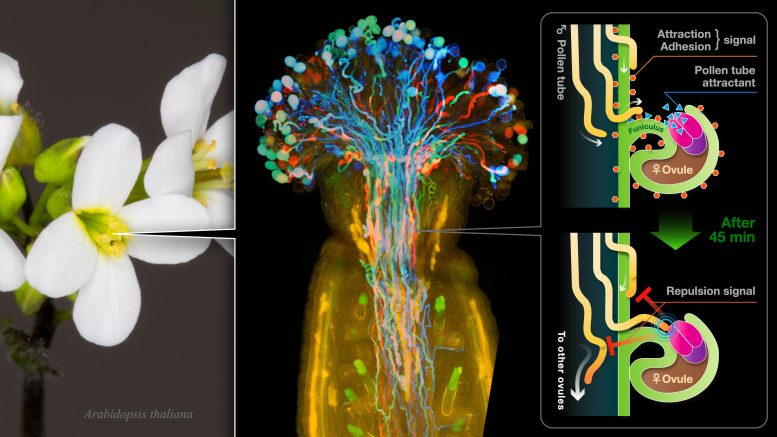How Female Flowers Pick Their Perfect Match

By

A study by Nagoya University reveals how Arabidopsis plants attract and repel pollen tubes using specific signals, aiding in precise fertilization and offering insights for agriculture. Credit: Issey Takahashi, edited
In a new study, published in EMBO Reports, researchers from Nagoya University explore the selective attraction and repulsion mechanisms in Arabidopsis plants during reproduction. Using a novel microscopic technique, they observed the unique way in which a female flower attracts a single male pollen tube while repelling others, ensuring precise and efficient fertilization. This research not only sheds light on the fundamental processes of plant reproduction but also suggests ways to enhance seed production and address challenges in agriculture.
Angiosperms, also known as flowering plants, contain both male and female reproductive organs. During reproduction, a pollen grain carrying male gametes lands on the stigma of a flower, initiating the growth of a pollen tube. This tube travels through the style and into the ovary, enabling sperm cells to fertilize the egg and central cells within an ovule.
Breakthroughs in Microscopic Imaging
In their study, the researchers developed a novel microscopic technique using a two-photon microscope. According to the lead author, Yoko Mizuta, the three-year effort was like a journey. “It involved delicate sample handling techniques and optimization of conditions, such as excitation wavelengths, for achieving deep imaging of flowers,” she said.

Deep imaging reveals dynamics and signaling in one-to-one pollen tube guidance. Credit: Issey Takahashi
New Insights Into Pollen Tube Dynamics
Their innovative technique allowed the team to observe the elongation of multiple pollen tubes within a living pistil and their unique attraction to female tissue for the first time. This allowed them to identify a signal emitted by the maternal tissue that attracts pollen tubes by leading them to elongate along the stamen tissue and reach the site of fertilization. This is the signal that enables the precise management of one-to-one pollen tube guidance.
One-to-one pollen tube guidance is a critical process in plant reproduction that involves precise navigation of pollen tubes to individual ovules. This mechanism ensures the successful fertilization of angiosperms by facilitating the specific coupling between ovules and individual pollen tubes.
The study not only uncovered the attraction mechanisms but also identified a repulsion signal that prevents multiple fertilizations of the same ovule, directing pollen tubes towards unfertilized ones. In addition to the 45-minute blocking process that prevents multiple sperm from fertilizing the same ovule, a repulsion signal also directs rejected suitors toward other unpaired ovules.
“I find the repulsion system fascinating,” Mizuta said. “The cells that generate the attraction system are mostly synergid cells, whereas the cells that generate the repulsion system include multiple types such as somatic and gametophytic cells at multistep levels. I find it very interesting that all couplings involve this mechanism of attracting and repelling.”
Further analysis showed the complexity of the one-to-one pollen tube guidance process, revealing an intricate regulatory mechanism that requires the involvement of various cells in both male and female plants. This precise regulation ensures successful fertilization and efficient seed production, particularly under challenging environmental conditions.
Implications for Agriculture
Mizuta emphasized the importance of this mechanism in maximizing seed production. “By precisely orchestrating the behavior of pollen tubes, plants have evolved a mechanism to ensure successful fertilization and efficient seed production on dry land with a limited number of suitors,” she said. This research provides valuable information about how plants reproduce and has the potential to benefit agricultural breeding by increasing seed production and improving germination rates.
Reference: “Deep imaging reveals dynamics and signaling in one-to-one pollen tube guidance” by Yoko Mizuta, Daigo Sakakibara, Shiori Nagahara, Ikuma Kaneshiro, Takuya T Nagae, Daisuke Kurihara and Tetsuya Higashiyama, 21 May 2024, EMBO Reports.
DOI: 10.1038/s44319-024-00151-4


